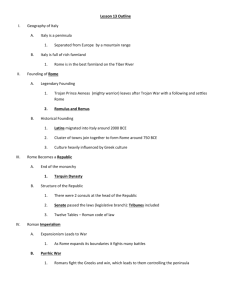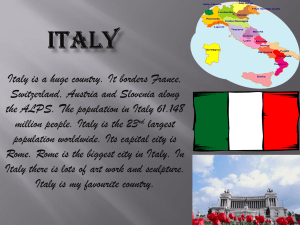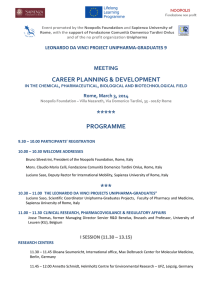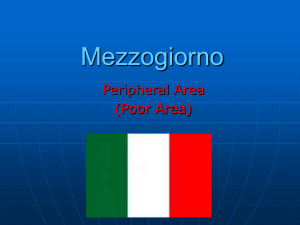Exploring Italy
advertisement
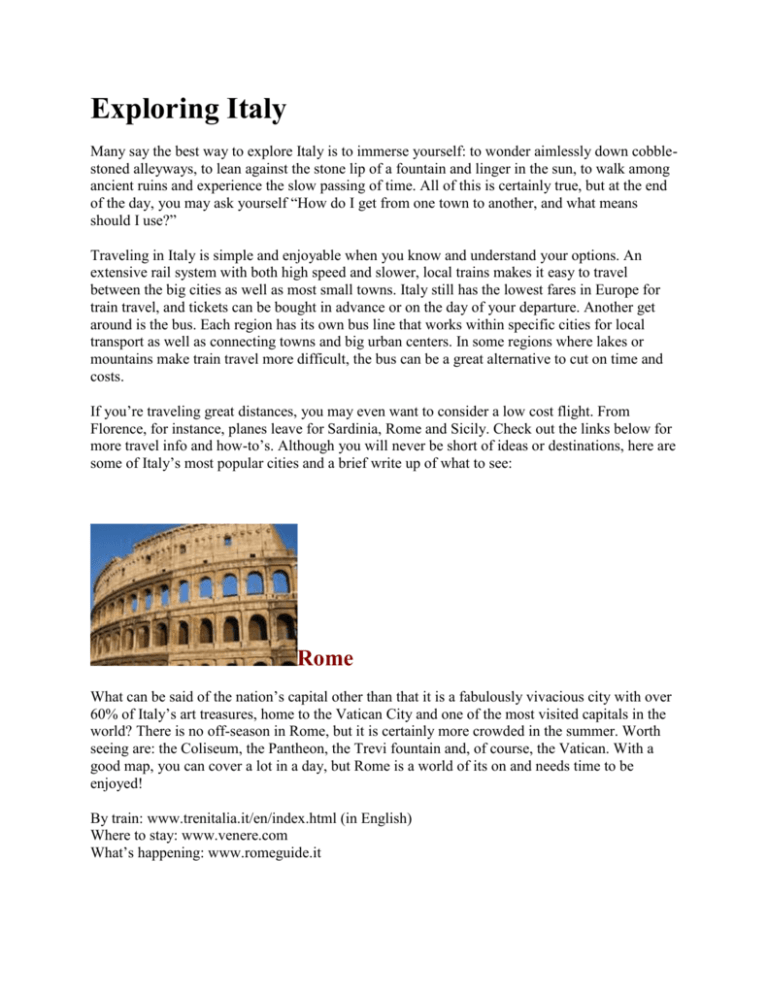
Exploring Italy Many say the best way to explore Italy is to immerse yourself: to wonder aimlessly down cobblestoned alleyways, to lean against the stone lip of a fountain and linger in the sun, to walk among ancient ruins and experience the slow passing of time. All of this is certainly true, but at the end of the day, you may ask yourself “How do I get from one town to another, and what means should I use?” Traveling in Italy is simple and enjoyable when you know and understand your options. An extensive rail system with both high speed and slower, local trains makes it easy to travel between the big cities as well as most small towns. Italy still has the lowest fares in Europe for train travel, and tickets can be bought in advance or on the day of your departure. Another get around is the bus. Each region has its own bus line that works within specific cities for local transport as well as connecting towns and big urban centers. In some regions where lakes or mountains make train travel more difficult, the bus can be a great alternative to cut on time and costs. If you’re traveling great distances, you may even want to consider a low cost flight. From Florence, for instance, planes leave for Sardinia, Rome and Sicily. Check out the links below for more travel info and how-to’s. Although you will never be short of ideas or destinations, here are some of Italy’s most popular cities and a brief write up of what to see: Rome What can be said of the nation’s capital other than that it is a fabulously vivacious city with over 60% of Italy’s art treasures, home to the Vatican City and one of the most visited capitals in the world? There is no off-season in Rome, but it is certainly more crowded in the summer. Worth seeing are: the Coliseum, the Pantheon, the Trevi fountain and, of course, the Vatican. With a good map, you can cover a lot in a day, but Rome is a world of its on and needs time to be enjoyed! By train: www.trenitalia.it/en/index.html (in English) Where to stay: www.venere.com What’s happening: www.romeguide.it Venice An all-time favorite of poets, bohemian travelers, lovers, and just about every tourist who comes through Italy these days, Venice never ceases to please the crowds. It is a spectacular city in just about every season, with its narrow water-ways, gondolas, and bustling markets. Venice is fascinating whether it is during winter, when the fog rolls in off the Adriatic, or during the hottest months when the streets fill not only with pigeons but also many many tourists. By train: www.trenitalia.it/en/index.html Where to stay: www.venere.com More info: europeforvisitors.com/venice Cinque Terre Cinque Terre (literally meaning “the five lands” or “five towns”) becomes a more popular destination every year, both for visitors to Italy and the locals themselves. As such, it’s also known as “the Italian Riviera.” Found on the Ligurian cost, these delightful little towns are better reached by train, as there are few roads that lead into residential areas. The reason for this is because the villages literally cascade down the cliff faces, making it impossible to construct anything other than staircases and winding alleys. There is a great trail that connects all five towns, offering spectacular vistas over the Mediterranean, as well as the possibility for swimming, boating and biking in the warmer months. During the high season, it can be difficult to find inexpensive accommodation – try a neighbouring town, Levanto, for a place to stay (not to far, some have ventured to call it the “sixth cinque terre”). How to reach it: you have to take a train till La Spezia (www.trenitalia.it/en/index.html) and then catch a bus to the different destinations (Monterosso al Mare, Vernazza, Riomaggiore) Info: www.aptcinqueterre.sp.it Where to Stay: en.venere.com/mediterranean_sea/italian_riviera/cinque_terre or www.hostelworld.com Orvieto Way down in the southwest corner of Umbria, Orvieto is on the main railway line between Rome and Florence. Orvieto sits on a hill made of volcanic tufa rock and has marvelous views of the surrounding country side, as well as an awe-inspiring duomo. While you’re there, try the great white wine, and take the fascinating “hidden Orvieto” tour of the grottoes that the Etruscans carved into the rock underneath the city. One of the coolest underground things is an enormous well carved into the rock on the orders of some sixteenth-century pope: it has interlocking staircases so that a continuous line of donkeys could ascend to get water and bring it back up without blocking each other. By train: www.trenitalia.it/en/index.html Where to stay: www.venere.com Bologna It’s relatively close to Florence (approx. 1 hour by train) and has been judged one of Italy’s most livable cities. Bologna is surrounded by hills though it sits on the plain of Emilia Romagna, and has much to offer in the way of Renaissance art and architecture, culture and cuisine, not to mention a thriving student ambiance that really brings this ancient city to life. There is much to see in Bologna: the university, for instance, founded over 900 years ago, is a competitive academic center that attracts students and scholars from all over the world. There is also the Piazza Maggiore and the Fountain of Neptune – both with great historic importance and both excellent photo ops! By train: www.trenitalia.it/en/index.html (in English) Where to stay: www.venere.com Ravenna Ravenna lived its moment of glory in the period from the V to the VII centuries. It briefly took the place of Rome as the capital of the Western part of the vast Roman empire, was then the capital of the Ostrogoths who caused the fall of Rome, and finally of the Byzantine protectorate under Justinian. From that early Christian period remain the many churches containing the famed gold leaf mosaics which astound the visitor with the sheer extension and dimensions of these works, their beauty and antiquity. Students can visit workshops where restorers and modern day mosaic craftsmen still perpetuate the ancient mosaic techniques. Fully eight monuments in Ravenna have been declared Patrimony of Humanity by UNESCO, all dating from the V and VI centuries. Today Ravenna is a charming small Italian city, capital of the Romagna region. In addition to the extraordinary wealth of ancient mosaics, an important monument to visit is the tomb of Dante, who died here in 1321 while in exile from Florence. Ravenna still refuses to give his remains to his native city! By train: www.trenitalia.it/en/index.html (in English) Where to stay: en.venere.com/hotels_ravenna Capri Also known as Paradise on Earth, the island of Capri is a long-time hang out of the rich and famous. It is found 25km off the cost of Naples and is famed as one of the most beautiful visitor destinations in Italy. It is easy to get to, but in the summer months tourists swarm the island, which takes away from its charm and “small-town” feel. It also means that food and accommodations are exorbitantly more expensive than you would find on the mainland. For that reason, many find it convenient to combine a trip to Capri with a visit to Naples, Sorrento or near-by Pompeii, using the mainland as a base to explore other areas. Not to be missed on the island are the whitewashed towns of Capri, Anacapri, the famed Faraglioni rock formations, and Villa Jovis. About Capri: www.capri.com Milan Italy’s fashion capital is a bustling urban center in the country’s north, not far from beautiful Lake Como, the Alps, not to mention the French, Swiss, and Austrian boarders. Apart from great shopping, there are noteworthy attractions in Milan such as their 15th century gothic Duomo, the impressive Sforza Castle and the Pinacoteca in Brera Art gallery. It is, however, a three-hour train trip from Florence, and is not recommended as a day trip. By train: www.trenitalia.it/en/index.html Where to stay: www.venere.com
